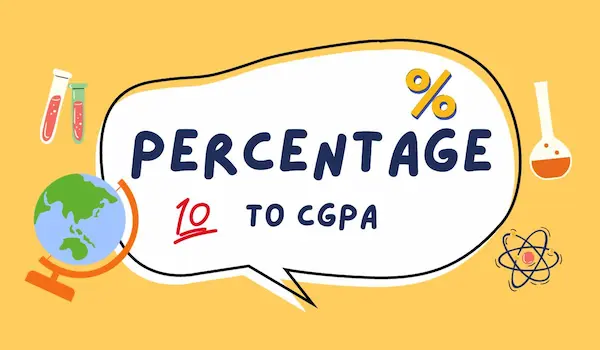Percentage to CGPA Calculator
What Is Percentage to CGPA Calculator?
It is the best CGPA calculator on the internet that can easily convert Percentage to CGPA with just a single click.
Change Percentage to CGPA fast.
Check total grades for all subjects together.
See every subject’s marks in detail.
Simple and clear grade-to-point conversion.
Have you ever wondered how a Cumulative Grade Point Average (CGPA) is calculated using your percentage scores? Knowing how to convert this information is like having a secret key to success in the classroom, where every mark matters. This information is essential whether you are a parent attempting to understand report cards, a student hoping to get into a prestigious university, or an educator influencing futures. Come explore this fascinating world with us as we simplify and make sense of complicated grading methods. Prepare yourself to solve the puzzles surrounding CGPAs and percentages—it’s not as hard as you might imagine!

Comprehending Percentage Scores
The foundation of traditional academic grading is percentage scores and these are more than just numbers on a report card. They are a common way to measure how well a student performed on assignments or tests. Let’s take a closer look:
Fundamental Idea: A student’s percentage score indicates their accomplishment relative to the highest potential score. A score of 75 out of 100, for instance, corresponds to a 75% achievement rate.
Evaluation Standard: Percentage scores are the main metric used in most educational institutions, especially at the school level, to assess student achievement.
Method of Calculation: Divide the entire number of marks received by the highest number of potential marks, and then multiply the result by 100 to get the percentage score. For example, If you got 550 out of 600 then the percentage would be (550/600)*100 = 91.67
Fine-Grained Analysis: By providing a detailed evaluation of a student’s performance in each topic, these scores facilitate the identification of both strengths and deficiencies.
Cultural Context: High percentage scores are frequently regarded as a standard for academic distinction in several educational environments, especially in India.
Transition to Higher Education: Grading systems frequently change from percentages to CGPA or GPA as students advance to higher education, particularly in universities. This change requires a thorough comprehension of the correlations between these two systems.
Understanding Grading System
In order to assess student performance and monitor academic advancement, grading systems are essential. They provide feedback on a student’s comprehension of the subject matter by assigning numerical or letter grades. Different educational institutions and nations have different grading systems:
Letter Grades:- Letter grades are popular in the US and allow students to compare their performance to that of their peers. They go from A for extraordinary achievement to F for subpar work.
Number Grades: Based on an evaluation of a student’s performance in comparison to peers, assign grades on a scale of 0-100 or 1-10.
Pass/Fail: Provides pupils with the chance to exhibit their mastery of a subject without the burden of traditional grading; especially useful for kids who face difficulties or have special needs.
The Requirement to Convert to CGPA
Because different institutions and nations have different grading systems, it is necessary to convert percentages to CGPA. While some colleges employ a CGPA method, others use a percentage-based approach. This disparity can make it difficult to compare academic achievements accurately. This is why a trustworthy conversion technique is essential for students, teachers, and employers especially in the context of globalisation.
Introducing the Percentage to CGPA Converter Tool

The conversion of percentage scores to CGPA, a common metric used by many academic institutions to evaluate students’ overall performance, is made easier with the help of the Percentage to CGPA Converter Tool. The conversion is predicated on a predetermined mapping that adheres to uniform principles despite variations among institutions. A given CGPA rating is typically linked to a range of percentage scores:
For Example:
- 35% is equivalent to 3.7 CGPA
- 40% is equivalent to 4.2 CGPA
- 45% is equivalent to 4.7 CGPA
- 50% is equivalent to 5.3 CGPA
- 55% is equivalent to 5.8 CGPA
- 60% is equivalent to 6.3 CGPA
- 65% is equivalent to 6.8 CGPA
- 70% is equivalent to 7.4 CGPA
- 75% is equivalent to 7.9 CGPA
- 80% is equivalent to 8.4 CGPA
- 85% is equivalent to 8.9 CGPA
- 90% is equivalent to 9.5 CGPA
- 95% is equivalent to 10 CGPA
This mapping offers a consistent way to convert percentage scores to CGPA, which makes it a very useful tool for students switching between different kinds of schooling or for apps that need a consistent way to evaluate students.
Comparing the Percentage Scoring System with the CGPA
Comparing CGPA and percentage systems is crucial for understanding their impact on academic assessment
- Basis of Assessment: Percentages are direct scores received in exams or assignments, whereas CGPA is the average grade point representing overall achievement over all topics and semesters.
- Granularity: A more detailed picture of performance in individual subjects can be obtained by examining percentage scores. CGPA provides a combined perspective.
- Scale: While percentages are given out of 100, CGPAs are usually given on a 1–10 or 4-point scale.
- Interpretation: While percentages provide a thorough subject-by-subject analysis, CGPA offers a comprehensive assessment that is helpful for a broad picture of a student’s performance.
Useful Examples and Applications

Applications for converting a percentage to a CGPA are practical.
Academic Transcripts: It is necessary for students to convert their percentage results to CGPA when applying to universities or nations where CGPA is the norm.
Applications for Jobs: Employers may like CGPA for a consistent evaluation of applicants, particularly in global corporations.
Example: For admissions to institutions overseas where CGPA is the standard, a student with an overall score of 85% in a percentage-based system could translate this to an estimated CGPA.
To Sum Up
It’s critical to understand and use the percentage to CGPA conversion in the context of the varied array of academic examinations. This information allows for easier transitions for professionals and students in international academic and professional settings by bridging the gap between disparate grading systems.
Faq
How to convert percentage to cgpa
General formula for Percentage to CGPA conversion is (Perentage/9.5). But keep in mind that different institutions use different formulas to calculate CGPA
70 Percentage to CGPA
70% is approximately equivalent to 7.4 CGPA based on the commonly used conversion chart
How to Calculate Percentage to CGPA out of 4
You can use our tool to calculate the percentage to CGPA out of 4. No need to use any maths, just enter your percentage, you will get your result
Is the percentage to CGPA conversion uniform across all institutions?
No, the conversion can vary between different educational institutions. It’s important to refer to the specific conversion guidelines of the institution in question.
Can I use the percentage to CGPA converter for job applications?
Yes, converting your percentage to CGPA can be useful for job applications, especially when the employer prefers or requires CGPA.
